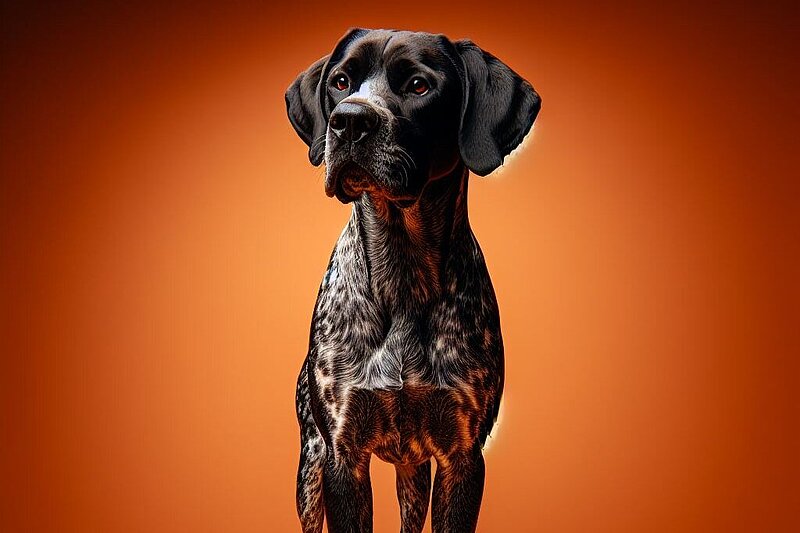The German Shorthaired Pointer: A versatile hunting dog and loyal companion
The history of the German Shorthair
The German Shorthaired Pointer has a long and proud history dating back to the 17th century. Originally, this breed came from Germany and was bred to create the ideal hunting dog. The ancestors of the German Shorthaired Pointer were Spanish and French pointing dogs that were crossed with native German dogs. The aim was to develop a dog that could be used for a variety of purposes - be it pointing, retrieving or water work. In the 19th century, English pointers were introduced into the breed in order to further refine the hunting characteristics. Today, the German Shorthaired Pointer is recognized worldwide as an excellent hunting dog and reliable companion.
Who is the German Shorthaired Pointer suitable for?
The German Shorthaired Pointer is ideal for active people who spend a lot of time outdoors and are looking for a loyal companion. Due to its strong hunting instinct and high energy level, this breed is particularly suitable for hunters and outdoor enthusiasts. Families with children who have plenty of space and time for exercise will find a loving and playful friend in the German Shorthaired Pointer. However, it is less suitable for people who live in small apartments or have little time for intensive exercise.
Character and behavior
The German Shorthaired Pointer is known for its friendly and balanced character. It is intelligent, eager to learn and extremely loyal to its family. This breed is generally good-natured and gets along well with children and other pets, provided it is socialized early. The German Shorthaired Pointer has a strong hunting instinct and high energy levels, so regular and challenging activities are necessary to keep him mentally and physically active.
Appearance and size
The German Shorthaired Pointer is a medium to large sized dog with an elegant and athletic build. Males reach a shoulder height of around 62 to 66 cm, while bitches are slightly smaller, with a shoulder height of 58 to 63 cm. The weight is between 25 and 32 kg for males and between 20 and 27 kg for females. Its coat is short, dense and shiny, usually in the colors brown, brown-white or black-white.
Grooming and health
Grooming the German Shorthair is relatively uncomplicated. Its short coat requires only occasional brushing to remove loose hair and keep the coat shiny. Regular checks of the ears, teeth and claws are also important in order to recognize and prevent health problems at an early stage.
Health-wise, the German Shorthair is a robust breed, although like many larger dogs, it is prone to hip dysplasia.
susceptible to hip dysplasia and other joint problems. Responsible breeders have their dogs tested for these and other hereditary diseases to minimize the risk. With proper care and regular veterinary check-ups, the German Shorthaired Pointer can live a long and healthy life, often 12 to 14 years.
Exercise requirements: A dog with lots of energy
The German Shorthaired Pointer is a dog that needs a lot of exercise and mental stimulation. Long daily walks, jogging or cycling are ideal for working off their energy. Hunting training, retrieving games and dog sports such as agility are also excellent ways to keep him mentally and physically busy. An underchallenged German Shorthaired Pointer can quickly develop behavioral problems, so it is important to provide him with enough opportunities to keep him busy. He can live in the city if there is enough exercise and movement, but he feels more comfortable in the countryside or in an environment with plenty of open space.
Training tips for the German Shorthair
Due to its intelligence and eagerness to please, the German Shorthaired Pointer is relatively easy to train. Consistent but loving training is crucial. Early socialization and obedience training are important to ensure he is comfortable in a variety of situations. Training should be varied and challenging to keep his attention. Positive reinforcement through praise and rewards leads to the best results.
Care instructions: How to keep your German Shorthair fit and healthy
Grooming your German Shorthair is simple: brushing once a week is enough to keep the coat clean and shiny. More frequent brushing may be necessary during the shedding season in spring and fall. Make sure to check the ears regularly for dirt and infections and brush the teeth to prevent tartar build-up. Claws should be checked regularly and trimmed if necessary, especially if your dog walks a lot on soft surfaces and the claws do not wear down naturally.
Behavioral characteristics and interactions with children and other animals
The German Shorthair is generally friendly and patient with children, especially if he grows up with them. His energetic nature makes him a great playmate, though small children should be supervised to avoid accidental bumps or knockdowns. The German Shorthair gets along well with other pets if socialized early. However, its hunting instinct can be a problem, especially with smaller animals such as cats or rodents, so a slow and controlled introduction is important.
Recognition by the FCI and interesting facts
The German Shorthaired Pointer is recognized by the Fédération Cynologique Internationale (FCI) and belongs to Group 7: Pointing Dogs, Section 1.1: Continental Pointing Dogs. This recognition confirms its suitability and performance as a hunting dog and companion. Another interesting feature of this breed is its ability to adapt quickly to different tasks, whether in the field, in the water or as a loyal family dog.
